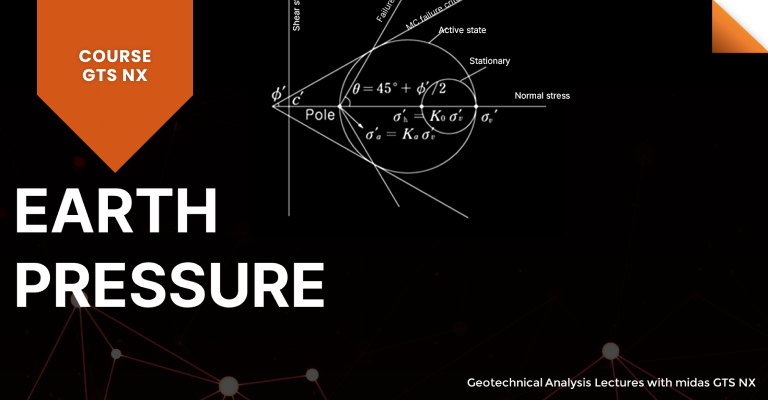-
1) What is Earth Pressure ?
-
2) Example
-
3) Comparison of Results

9. Earth Pressure
In this lecture, We will learn about the concepts and principles of Earth Pressure. We will understand the Active and Passive earth pressures deeply. Moreover, In order to comprehend the earth pressure utilizing GTS NX software, we will simulate the active and passive pressure of a retaining wall structure. The findings will be compared with those obtained manually and using the program.
Chapter 1) What Is Earth pressure.
- Introduction to slope stability.
- Earth pressure theory for Pressure at rest, Active and passive.
- Detailed discussion on Active and Passive earth pressure.
Chapter 2) Example
- Modelling, boundary condition setting, and applying load using Midas GTS NX software to numerically calculate the active and passive pressures of a retaining wall structure.
- Analysis and see the results for the same.
Chapter 3) Comparison of results.
- Compare the results with those obtained manually and using the program.
Summary
- Concept of the Retaining Structures
Ground-supported or retaining structures are installed in the subsurface or on slopes to secure living or activity spaces.
The supporting structure must be safe from collapse against the earth pressure acting on the structure by the ground. In order to examine the stability of the supporting structure, the magnitude of the earth pressure must be determined.
Soil pressure is governed by the relative stiffness that determines the deformation of supporting structures and the ground.
Particularly in the case of retaining walls, the state of ground failure is assumed, and it is dealt with in terms of active pressure and passive pressure.
Since soil pressure deals with the state of failure, it corresponds to stability issues.

2. Earth Pressure Theory
Earth pressure should be calculated according to the shape and purpose of the supporting structure.

Figure 9.2 represents the types of soil retaining walls.
Here, we examine the active pressure and passive pressure required for retaining wall design.
The earth pressure acting on a retaining wall is a function of the wall displacement.
Earth pressure when there is no displacement before the structure is installed is called static earth pressure.
If the structure undergoes rotational deformation towards the backfill, as shown in Figure 9.3, the backfill soil reaches a state of failure due to compression.
The soil pressure acting, in this case, is referred to as Rankine's passive pressure.
On the other hand, if the structure undergoes rotational deformation towards the excavation side, the backfill soil fails due to relaxation.
The soil pressure acting on the back face of the structure in this case is referred to as Rankine's active pressure.
(1) Static earth pressure (initial condition)
Let's assume that a soil element with constrained horizontal movement is subjected to vertical stress 𝜎𝑣′ and horizontal stress 𝜎ℎ′.
These pressures are called confining pressures. The horizontal stress is expressed using the vertical stress as follows:

When representing the stresses in a state of equilibrium on a Mohr circle, the plot is drawn inward toward the failure plane.
(2) Active earth pressure
When a retaining wall in a state of equilibrium undergoes sufficient deformation towards the opposite side of the backfill, causing the soil to reach a state of failure, the stress state on the back face of the wall is referred to as the active state.
The active state occurs when the horizontal displacement of the retaining wall's cross-section is approximately 0.001H in loose sand and about 0.04H in soft clay, where H is the height of the wall.
A) Rankine active earth pressure
Rankine's (1857) theory of active pressure was derived under the assumption that the retaining wall undergoes sufficient displacement, causing the backfill soil to reach a state of imminent failure, as shown in Figure 9.4.
This state is represented by a Mohr circle as depicted in Figure 9.5. In other words, the horizontal stress decreases, causing the Mohr circle to reach the failure state.

B) Coulomb active earth pressure
Coulomb's (1776) theory of active pressure assumes that the failure mass of the backfill soil forms a wedge with a horizontal plane and an angle 𝜃cr.
Coulomb's active pressure can be obtained from the equilibrium condition of forces acting on the failure wedge and the condition of maximizing the supporting soil pressure of the retaining wall (satisfying dP/d𝜃 = 0) as shown in equation 9.3.

In the case of a vertical retaining wall with horizontal backfill, Coulomb's active pressure becomes equal to Rankine's pressure.
Since 𝛿=𝛼=0 and 𝜃cr=45+∅'/2, if we substitute these values into equation 9.3 for 𝐾a, we get 𝐾a=tan2(45°-∅'/2).
(3) Passive earth pressure
When a retaining wall in a state of equilibrium undergoes sufficient deformation towards the backfill, causing the soil to reach a state of compressive failure, the stress state on the back face of the wall is referred to as the passive state.
The passive state occurs when the horizontal displacement of the retaining wall's cross-section is approximately 0.01H in loose sand and about 0.05H in soft clay, where H is the height of the wall.
A) Rankine passive earth pressure
Rankine's (1857) theory of passive pressure was derived under the assumption that the retaining wall undergoes sufficient compressive deformation, causing the backfill soil to reach a state of imminent failure, as depicted in Figure 9.7.
This state is represented by a Mohr circle as shown in Figure 9.8. As the horizontal stress increases, causing the Mohr circle to reach the failure state.

B) Coulomb passive earth pressure
Coulomb (1776) assumed that in the case of passive pressure, the failure mass of the backfill soil forms a wedge with a horizontal plane and an angle 𝜃cr due to the frictional forces during compression failure.
Coulomb's passive pressure can be obtained from the equilibrium condition of forces acting on the failure wedge and the condition of minimizing the supporting soil pressure of the retaining wall (satisfying dP/d𝜃 = 0) as shown in equation 9.6.

